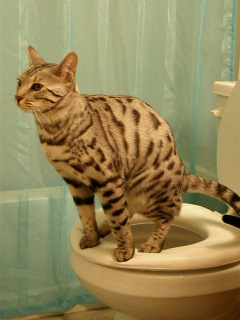Reasons You Should Never Flush Cat Poop Down Your Toilet - Critical Information
Reasons You Should Never Flush Cat Poop Down Your Toilet - Critical Information
Blog Article
Listed here down the page you can find some quality information and facts related to Don’t flush cat feces down the toilet.

Introduction
As cat proprietors, it's vital to be mindful of exactly how we take care of our feline pals' waste. While it might appear hassle-free to purge feline poop down the commode, this method can have damaging effects for both the atmosphere and human health and wellness.
Ecological Impact
Flushing pet cat poop presents harmful microorganisms and parasites into the supply of water, posing a considerable threat to aquatic ecological communities. These contaminants can negatively impact marine life and concession water top quality.
Health and wellness Risks
Along with environmental issues, flushing pet cat waste can also present health dangers to humans. Cat feces might include Toxoplasma gondii, a parasite that can create toxoplasmosis-- a possibly serious illness, especially for expecting women and individuals with weakened body immune systems.
Alternatives to Flushing
Luckily, there are more secure and more accountable means to get rid of pet cat poop. Take into consideration the following alternatives:
1. Scoop and Dispose in Trash
The most typical method of disposing of cat poop is to scoop it into a naturally degradable bag and toss it in the trash. Make certain to use a dedicated litter scoop and take care of the waste immediately.
2. Use Biodegradable Litter
Select biodegradable cat trash made from materials such as corn or wheat. These clutters are eco-friendly and can be securely taken care of in the garbage.
3. Hide in the Yard
If you have a yard, consider hiding feline waste in an assigned location away from vegetable yards and water resources. Be sure to dig deep sufficient to prevent contamination of groundwater.
4. Set Up a Pet Waste Disposal System
Purchase an animal waste disposal system especially made for cat waste. These systems utilize enzymes to break down the waste, decreasing odor and ecological influence.
Verdict
Accountable pet ownership prolongs past offering food and sanctuary-- it additionally involves correct waste administration. By avoiding purging feline poop down the toilet and choosing alternative disposal methods, we can reduce our environmental footprint and safeguard human health.
Why Can’t I Flush Cat Poop?
It Spreads a Parasite
Cats are frequently infected with a parasite called toxoplasma gondii. The parasite causes an infection called toxoplasmosis. It is usually harmless to cats. The parasite only uses cat poop as a host for its eggs. Otherwise, the cat’s immune system usually keeps the infection at low enough levels to maintain its own health. But it does not stop the develop of eggs. These eggs are tiny and surprisingly tough. They may survive for a year before they begin to grow. But that’s the problem.
Our wastewater system is not designed to deal with toxoplasmosis eggs. Instead, most eggs will flush from your toilet into sewers and wastewater management plants. After the sewage is treated for many other harmful things in it, it is typically released into local rivers, lakes, or oceans. Here, the toxoplasmosis eggs can find new hosts, including starfish, crabs, otters, and many other wildlife. For many, this is a significant risk to their health. Toxoplasmosis can also end up infecting water sources that are important for agriculture, which means our deer, pigs, and sheep can get infected too.
Is There Risk to Humans?
There can be a risk to human life from flushing cat poop down the toilet. If you do so, the parasites from your cat’s poop can end up in shellfish, game animals, or livestock. If this meat is then served raw or undercooked, the people who eat it can get sick.
In fact, according to the CDC, 40 million people in the United States are infected with toxoplasma gondii. They get it from exposure to infected seafood, or from some kind of cat poop contamination, like drinking from a stream that is contaminated or touching anything that has come into contact with cat poop. That includes just cleaning a cat litter box.
Most people who get infected with these parasites will not develop any symptoms. However, for pregnant women or for those with compromised immune systems, the parasite can cause severe health problems.
How to Handle Cat Poop
The best way to handle cat poop is actually to clean the box more often. The eggs that the parasite sheds will not become active until one to five days after the cat poops. That means that if you clean daily, you’re much less likely to come into direct contact with infectious eggs.
That said, always dispose of cat poop in the garbage and not down the toilet. Wash your hands before and after you clean the litter box, and bring the bag of poop right outside to your garbage bins.
https://trenchlesssolutionsusa.com/why-cant-i-flush-cat-poop/

I'm just very fascinated by Can You Flush Cat Poo or Litter Down the Toilet? and I'm hoping you appreciated my blog entry. For those who enjoyed reading our blog post if you please make sure you remember to share it. I enjoy reading our article about Don’t flush cat feces down the toilet.
Call Today Report this page